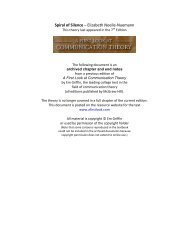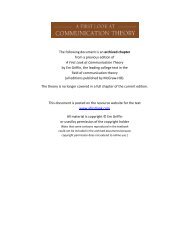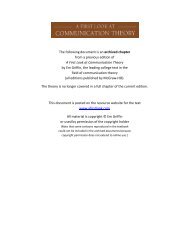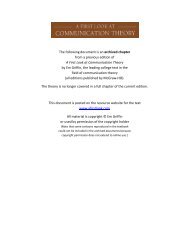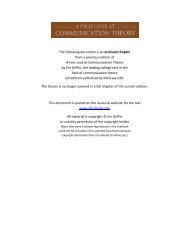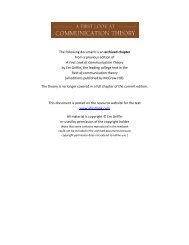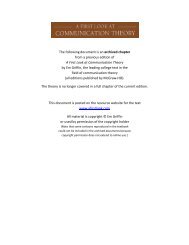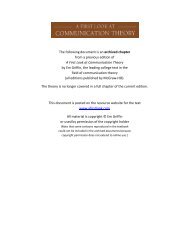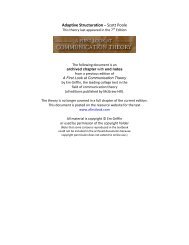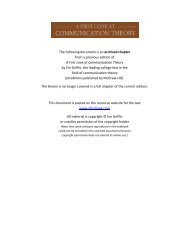Interpersonal Deception Theory (PDF) - A First Look at ...
Interpersonal Deception Theory (PDF) - A First Look at ...
Interpersonal Deception Theory (PDF) - A First Look at ...
- No tags were found...
You also want an ePaper? Increase the reach of your titles
YUMPU automatically turns print PDFs into web optimized ePapers that Google loves.
The following document is an archived chapterfrom a previous edition ofA <strong>First</strong> <strong>Look</strong> <strong>at</strong> Communic<strong>at</strong>ion <strong>Theory</strong>by Em Griffin, the leading college text in thefield of communic<strong>at</strong>ion theory(all editions published by McGraw-Hill).The theory is no longer covered in a full chapter of the current edition.This document is posted on the resource website for the textwww.afirstlook.comAll m<strong>at</strong>erial is copyright © Em Griffinor used by permission of the copyright holder(Note th<strong>at</strong> some cartoons reproduced in the textbookcould not be included in the archived documents becausecopyright permission does not extend to online use.)
CHAPTER 7<strong>Interpersonal</strong> <strong>Deception</strong><strong>Theory</strong>of David Buller & Judee BurgoonDavid Buller (AMC Cancer Research Center, Denver) and Judee Burgoon (Universityof Arizona) have conducted over two dozen experiments in which theyask participants to deceive another person. These researchers explain th<strong>at</strong> peopleoften find themselves in situ<strong>at</strong>ions where they make st<strong>at</strong>ements th<strong>at</strong> are less thancompletely honest in order "to avoid hurting or offending another person, to emphasizetheir best qualities, to avoid getting into a conflict, or to speed up or slowdown a rel<strong>at</strong>ionship."l Put yourself in the following situ<strong>at</strong>ion and consider howyou might respond:You've been d<strong>at</strong>ing P<strong>at</strong> for nearly three years and feel quite close ill your rel<strong>at</strong>ionship.Since P<strong>at</strong> goes to a different school upst<strong>at</strong>e, the two of you have agreed to d<strong>at</strong>e otherpeople. Nevertheless, P<strong>at</strong> is quite jealous and possessive. During the school year yousee P<strong>at</strong> only occasionally, but you call each other every Sunday and talk for over anhour. On Friday one of your friends invites you to a party on S<strong>at</strong>urday night, but theparty is "couples only" so you need a d<strong>at</strong>e. There's no way th<strong>at</strong> P<strong>at</strong> could come downfor the weekend. You decide to ask someone from your comm class who you've been<strong>at</strong>tracted to so th<strong>at</strong> you can go to the party. The two of you go and have a gre<strong>at</strong> time.On Sunday afternoon, there's a knock on your door and it's P<strong>at</strong>. P<strong>at</strong> walks in andsays, "1 decided to come down and surprise you. 1 tried calling you all last night, butyou weren't around. Wh<strong>at</strong> were you doing?"2Buller and Burgoon discuss three types of response you might give if you decidenot to tell the truth, the whole truth, and nothing but the truth. <strong>First</strong>, yOll could lie:"1 was <strong>at</strong> the library getting ready for my comm theory exam." Second, you couldtell part of the truth while leaving out important details: "1 went to a party <strong>at</strong> afriend's apartment." Or third, you could be intentionally vague or evasive: "1went out for a while."97
98 IN IERI'I!,SUN/1L COMMUNICATIONThe book contains a New Yorker cartoon here.Permission to reproduce the cartoon wasgranted for the original public<strong>at</strong>ion only anddoes not include reproduction in the online archive.Following the lead of others who study verbal deceit, Buller and Burgoonlabel these three str<strong>at</strong>egiesfalsific<strong>at</strong>iun, concealment, and equivoc<strong>at</strong>ioll. The three differin th<strong>at</strong> falsific<strong>at</strong>ion cre<strong>at</strong>es a fiction, concealment hides a secret, and equivoc<strong>at</strong>iondodges the issue. Yet all three messages fall under the umbrella concept of deceptioll,which Buller and Burgoon define as "a message knowingly transmitted bya sender to foster a false belief or conclusion bv the receiver."3Would P<strong>at</strong> be able to spot the deception? <strong>Interpersonal</strong> deception theory saysprobably not. Yet most people are confident they could, and it's doubtful th<strong>at</strong> thisjealous romantic partner would be an exception." Working on the popular assumptionth<strong>at</strong> nonverbal communic<strong>at</strong>ion is hard to fake, P<strong>at</strong> would probablycheck your facial expression and listen to the sound of your voice to confirm ordisconfirm your answer.Folk wisdom provides a r<strong>at</strong>ionale for monitoring nonverbal cues for signs ofdeceit. When people won't look us straight in the eye, we assume they have somethingto hide. We also tend to believe th<strong>at</strong> nervous laughter and hurried speech reflectthe fear of being caught in a lie.
CH:\fT1El\ 7: INTU,PLRSONAL DECl:P'llON THEORY99Although this thinking represents"common sense," the bulk of deception researchshows th<strong>at</strong> these particular nonverbal cues are not reliable indic<strong>at</strong>ors of deception.5 A chuckling, fast-talking person who avoids eye contact is just as likelyto be telling the truth as is someone who displays the socially accepted signs ofsincerity. When tested under controlled labor<strong>at</strong>ory conditions, people rarely aremore than 60 percent accur<strong>at</strong>e in their ability to spot deception, while a just-bychance50 percent detection r<strong>at</strong>e is more common. It appears th<strong>at</strong> P<strong>at</strong> may neverknow for sure wh<strong>at</strong> you did or how you felt on S<strong>at</strong>urday night.AN EMERGENT THEORY OF STRATEGIC INTERACTIONDavid Buller and Judee Burgoon discount the value of highly controlled studiesdesigned to isol<strong>at</strong>e unmistakable cues th<strong>at</strong> people are lying. They agree th<strong>at</strong>human beings are r<strong>at</strong>her poor lie detectors, but they don't think th<strong>at</strong> the typicalone-way communic<strong>at</strong>ion experiment is a helpful way to explore the reason why.They point out th<strong>at</strong> past research has usually involved people listening to scriptedmessages recorded by strangers with whom they've had no chance to interact.This st<strong>at</strong>ic approach to deception ignores communic<strong>at</strong>ion dynamics and focusesinstead on internal thought processes-behind-the-eyes explan<strong>at</strong>ions for liars'manipul<strong>at</strong>ive behavior or the na·ive acceptance of gullible listeners. Buller notesth<strong>at</strong> "rarely is it acknowledged th<strong>at</strong> receivers react to deceivers' messages and th<strong>at</strong>these reactions alter the communic<strong>at</strong>ion exchange and, perhaps, deception's success."6At the start of the 1990s he proclaimed the need for an interpersonal deceptiontheory th<strong>at</strong> wouldexplain the interplay between active deceivers and detectors who communic<strong>at</strong>e withmultiple motives, who behave str<strong>at</strong>egically, whose communic<strong>at</strong>ion behaviors mutuallyinfluence one another to produce a sequence of moves and countermoves, and whosecommunic<strong>at</strong>ion is influenced by the situ<strong>at</strong>ion in which the deception transpires.?<strong>Interpersonal</strong> deception theory is the result. Figure 7-1 is a paraphrased digestof the 18 propositions th<strong>at</strong> appeared in a 1996 issue of Communic<strong>at</strong>ion <strong>Theory</strong>dedic<strong>at</strong>ed to exploring Buller and Burgoon's theory. Although the theorists considertheir model as "work in progress," they arc committed to a set of unchangingassumptions concerning interpersonal communic<strong>at</strong>ion in general, and deceptionin particular. Most of these assumptions surface in their propositions, but twocore ideas stand out.1. <strong>Interpersonal</strong> communic<strong>at</strong>ion is interactive. If the encounter betweenyou and P<strong>at</strong> actually took place, both of you would be active participants, constantlyadjusting your behavior in response to feedback from each other. Wh<strong>at</strong>everstory you tell, you shouldn't expect P<strong>at</strong> to remain verbally and nonverballymute. One way or another, you'll get a response. In order to capture the reality oftwo-way communic<strong>at</strong>ion in flux, I've substituted the term respondent for the morepassive term listener in my paraphrase of Buller and Burgoon's propositions.Interaction, r<strong>at</strong>her than individuality, is <strong>at</strong> the core of their theory.
100 lNTERPEI
CHAPTER 7: INTEJ
102 IMTEl\l'rRSLJNAL Cl)i'dJ'vlUNICA7 !ONevalu<strong>at</strong>ion is complic<strong>at</strong>ed, however, because every deceptive act has <strong>at</strong> least threeaims-to accomplish a specific task, to establish or maintain a rel<strong>at</strong>ionship withthe respondent, and to "save face," or sustain the image of one or both parties. Theweb of words the deceiver weaves has to work on multiple levels.The language used to achieve a specific task can be as varied as the peoplewho feel a need to deceive. Yet Buller and Burgoon suggest th<strong>at</strong> the interpersonaland identity motiv<strong>at</strong>ions inherent in deception stimul<strong>at</strong>e a recurring "text" th<strong>at</strong>marks the communic<strong>at</strong>ion as less than honest. Even though respondents probablywon't spot these signs in the ebb and flow of interaction, the theorists list fourmessage characteristics th<strong>at</strong> reflect str<strong>at</strong>egic intent.1. Uncertainty and vagueness. lf you don't want P<strong>at</strong> to know about S<strong>at</strong>urdaynight, you'll probably keep your answer short and noncommittal. If you say, "Jworked l<strong>at</strong>e," the brevity precludes detail and there's nothing concrete for P<strong>at</strong> tochallenge. Another typical way to not be pinned down is to speak in the passivevoice and use indefinite pronouns ("It was impossible to get things done beforethen").2. Nonimmediacy, reticence, and withdrawal. If P<strong>at</strong> shows up unexpectedlyand demands to know why you weren't in last night, you'll probably wish youweren't there now. Th<strong>at</strong> desire to be out of the situ<strong>at</strong>ion is often encoded in nonverbalactions. You might turn away to make coffee, sit farther apart than usual,or lean back r<strong>at</strong>her than forward as you answer. We should expect a moment of silencebefore you answer, and frequent pauses during your response would becommon. Words also show nonimmediacy when the speaker changes verbs frompresent to past tense-a linguistic move th<strong>at</strong> says in effect, ''I'm history."3. Disassoci<strong>at</strong>ion. While nonimmediacy is a str<strong>at</strong>egy of symbolically removingyourself from the situ<strong>at</strong>ion, disassoci<strong>at</strong>ion is a way of distancing yourself fromwh<strong>at</strong> you've done. If you talk about your S<strong>at</strong>urday night d<strong>at</strong>e, you are liableto choose language th<strong>at</strong> shifts much of the responsibility to others. Lee'elers areinclusive terms th<strong>at</strong> do this by removing individual choice ("But P<strong>at</strong>, everyonealways goes out on S<strong>at</strong>urday night"). Group references also suggest shared responsibility("We i!il went over to Holly's party together"). Modifiers downplay theintensity of unwelcome news ("Sometimes J get kind'llonely staying home on S<strong>at</strong>urdaynight"). All of these linguistic constructions sever the personal connectionbetween the actor and the act of deception.4. Image- and rel<strong>at</strong>ionship-protecting behavior. When people "practice to deceive,"they usually recognize th<strong>at</strong> nonverbal leakage could provide telltale signsth<strong>at</strong> the words they speak aren't wh<strong>at</strong> they know to be true. Since discovery couldhurt their reput<strong>at</strong>ions and thre<strong>at</strong>en their rel<strong>at</strong>ionships, they consciously strive tosuppress the bodily cues th<strong>at</strong> might signal deception. To mask the cues th<strong>at</strong> leakout despite their best efforts, they try to appear extra sincere. Deceivers in dialoguetend to nod in agreement when the respondent speaks, avoid interrupting,and smile frequently. As Buller and Burgoon note, "It appears th<strong>at</strong> smiling may bea simple, all-purpose str<strong>at</strong>egy enacted to cover up deceit."II) Jim Carrey's grinningpresence in the film Liar, Liar epitomizes this typical diversionary tactic.
CH,1VfER 7: INTU\I'ERSONAf. LH~CEI)TION F1iEORY103Those who desire a clear-cut way to separ<strong>at</strong>e truth telling from deception mighthope th<strong>at</strong> these four telltale signs of str<strong>at</strong>egic messages would provide an either/ orlitmus test for discerning honesty. But the world of interpersonal communic<strong>at</strong>ion isnot th<strong>at</strong> simple. Almost all communic<strong>at</strong>ion is intentional, goal directed, and mindful.According to Proposition 3, deceptive communic<strong>at</strong>ion is simply more so.Five of Buller and Burgoon's propositions show th<strong>at</strong> multiple factors stronglyaffect the extent of a deceiver's str<strong>at</strong>egic behavior. They claim th<strong>at</strong> this plan-basedactivity increases when the situ<strong>at</strong>ion is highly interactive (Prop. 4), when the partiesknow each other well (Prop. 8), when the deceiver particularly fears discovery(Prop. 6), when the deceiver's motiv<strong>at</strong>ion is selfish (Prop. 7), and when the deceiverhas good communic<strong>at</strong>ion skills (Prop. 9). It's not a stretch to think th<strong>at</strong> allfive of these intensifying factors will come into play if you decide to conceal,equivoc<strong>at</strong>e, or falsify. If you do, your mind will be whirling.Buller and Burgoon firmly believe th<strong>at</strong> str<strong>at</strong>egic moves aid successful deception.Yet even with all the high-intensity cognitive effort you might bring to the encounter,there's no guarantee th<strong>at</strong> you'll pull it off. <strong>Interpersonal</strong> deception theorysuggests th<strong>at</strong> the outcome depends not only on the quality of your message butalso on the nonstr<strong>at</strong>egic cues you can't control.lEAKAGE: THE TRUTH WILL COME OUT (MAYBE)A century ago, psychi<strong>at</strong>ric pioneer Sigmund Freud st<strong>at</strong>ed the case for using nonverbalcues to detect deception. Referring to a p<strong>at</strong>ient who wouldn't be truthfulabout his darkest thoughts and feelings, Freud observed, "If his lips are silent, hech<strong>at</strong>ters with his fingertips; betrayal oozes out of him <strong>at</strong> every pore." 11 Buller andBurgoon agree th<strong>at</strong> behavior outside of the deceiver's conscious control can signaldishonesty, and they basically endorse the well-known four-factor model ofdeception developed by University of Rochester social psychologist Miron Zuckermanto explain why this leakage occurS. 12<strong>First</strong>, deceivers' intense <strong>at</strong>tempt to control inform<strong>at</strong>ion can produce performancesth<strong>at</strong> come across as too slick, or "canned." Nonstr<strong>at</strong>egic inform<strong>at</strong>ion leaksusually go hand-in-hand with str<strong>at</strong>egic activity. Second, lying causes physiologicalarousal. Th<strong>at</strong>'s why a polygraph, which measures only autonomic responses, iscalled a "lie detector." Third, the predominant felt emotions th<strong>at</strong> accompany deceitare guilt and anxiety. Although "duping delight" is always a possibility, most peoplefeel bad about lying and are likely to show it. Finally, the complex cognitive jl7Ctorsinvolved in deception can tax the brain beyond its capacity. Cognitive overloadmeans some behaviors go untended.In a st<strong>at</strong>istical procedure called meta-analysis, Zuckerman combined the resultsof 35 different leakage studies conducted by various researchers to see wh<strong>at</strong>unintentional nonverbal behaviors usually accompany deception. 13 Freud'sdrumming fingers made the list as part of a c<strong>at</strong>egory called "self adapters"-fidgetyhand movements unrel<strong>at</strong>ed to wh<strong>at</strong> is said. Other telltale signs were• Increased blinking and enlarged pupils• Frequent speech errors (gramm<strong>at</strong>ical mistakes, repetitions, slips of the tongue)
104 INTFRPEJ(50NAJ COMMUNICATION• Increased speech hesit<strong>at</strong>ions (awkward pauses, "ahs, ers, ums")• Higher voice pitch• Increased discrepancies between verbal and nonverbal channelsNote th<strong>at</strong> smiling and other facial expressions didn't make the list. As Universityof Virginia social psychologist Bella DePaulo st<strong>at</strong>es, "Facial cues ... are indeedfaking cues."14 Apparently most of us are aware of our face's capacity to conveycomplex messages, and therefore we str<strong>at</strong>egically monitor and control th<strong>at</strong> displayfar more than we do our tone of voice or body movement.Buller and Burgoon contribute to the discussion of leakage by moving beyonda concern with micro-behaviors and focusing on the decline of the deceiver'soverall performance. Reflective of Burgoon's work with expectancy viol<strong>at</strong>ions (seeChapter 6), the theorists claim th<strong>at</strong> an unexpected move signals th<strong>at</strong> something iswrong. As Propositions 4, 9, and 10 suggest, a skilled communic<strong>at</strong>or oper<strong>at</strong>ing inan interactive context has a better chance of crafting a deceptive performance th<strong>at</strong>won't seem strange. But ultim<strong>at</strong>ely, the ability of the deceiver to "pull off" the deceptiondepends on how suspicious the respondent actually is.THE RESPONDENT'S DILEMMA: TRUTH BIAS OR SUSPICION?Five of Buller and Burgoon's propositions refer to our persistent expect<strong>at</strong>ion th<strong>at</strong>people will tell the truth (#s 5, 6, 10, 11,16). This was first labeled a "truth bias" bycommunic<strong>at</strong>ion researchers Steven McCornack (Michigan St<strong>at</strong>e University) andMalcolm Parks (University of Washington),15 and Burgoon and Buller have confirmedth<strong>at</strong> respondents tend to regard interpersonal messages as honest, complete,direct, relevant, and clear-even when the speaker is lying. lf ; So no m<strong>at</strong>terwh<strong>at</strong> you might say about S<strong>at</strong>urday night, P<strong>at</strong> probably will believe you.Why are people so easily fooled? Following the lead of social philosopherH. P. Grice, McCornack claims th<strong>at</strong> there exists an implied social contract th<strong>at</strong> all ofus will be honest with each other-a mutual agreement th<strong>at</strong> our messages willreflect reality as we know it. Since deception voids th<strong>at</strong> contract, it's hard for us tobelieve th<strong>at</strong> people will casually plunge us into social chaos. 17 Other deceptionresearchers suggest th<strong>at</strong> the expect<strong>at</strong>ion of honesty is a cognitive heuristic, a mentalshortcut used to bypass the huge clutter of verbal and nonverbal signals th<strong>at</strong>bombard us throughout every convers<strong>at</strong>ion. Unless deception is obvious from thestart, we "seize and freeze" on early signs of sincerity and effectively seal ourselvesoff from conflicting indic<strong>at</strong>ors. Wh<strong>at</strong>ever the reason for our assumption ofveracity, Buller and Burgoon are convinced th<strong>at</strong> people who know and like eachother are particularly resistant to doubting each others' words. The theorists suggestth<strong>at</strong> parties in close, warm rel<strong>at</strong>ionships are motiv<strong>at</strong>ed to find truth in wh<strong>at</strong>evera friend, romantic partner, or family member says. They therefore overlookor explain away st<strong>at</strong>ements th<strong>at</strong> others might find questionable. ISDespite a powerful and prevailing truth bias in face-to-face interaction, peoplecan come to doubt the honesty of another's words. P<strong>at</strong> may well be suspiciousof wh<strong>at</strong> you say. Buller and Burgoon define suspicion as a "st<strong>at</strong>e of doubt or dis
CHAPTER 7: INTERPERSONAL DECEPTION THEO/{)105trust th<strong>at</strong> is held without sufficient evidence or proof."l" As such, they picture suspicionas a midrange mindset loc<strong>at</strong>ed somewhere between truth and falsity:TRUE SUSPICION FALSEWe've already looked <strong>at</strong> the str<strong>at</strong>egic and nonstr<strong>at</strong>egic behavior of deceiversth<strong>at</strong> might cause others to become suspicious. Verbal tactics of vagueness, nonimmediacy,and disassoci<strong>at</strong>ion can make respondents wary; nonverbal signs of emotionalstress and mental meltdown may put listeners on guard. In fact, any communic<strong>at</strong>ionth<strong>at</strong> strikes respondents as strange or out of character is liable totrigger misgivings about the message or the messenger. Of course, some suspicionsmay be planted before the interaction even begins. From past experience, P<strong>at</strong>may know th<strong>at</strong> you aren't always truthful. Certainly P<strong>at</strong>'s jealousy will cre<strong>at</strong>e abuilt-in skepticism toward any explan<strong>at</strong>ion you might offer. Or a prior warningfrom a third party could taint the whole interaction.Given the many ways th<strong>at</strong> respondents could become suspicious, we mightimagine th<strong>at</strong> deceivers would lose their truth-bias advantage and have their deceptionunmasked for wh<strong>at</strong> it is. Not so. Buller and Burgoon have found th<strong>at</strong> it'sactually difficult to induce a deep-se<strong>at</strong>ed skepticism.20 On the rare occasions whenrespondents are highly suspicious, their doubts usually diminish after a few minutesof interaction.When respondents doubt a deceiver's honesty, they tend to avoid direct confront<strong>at</strong>ionin order to hide their suspicions. Instead, they adopt "a take charge interviewstyle but one th<strong>at</strong> is conducted under a pleasant guise."21 Smiling often,they gently probe for more inform<strong>at</strong>ion r<strong>at</strong>her than directly challenging the deceiver'sst<strong>at</strong>ements. Buller and Burgoon have discovered scant evidence th<strong>at</strong> theseprobes help respondents unmask deception. On the contrary, the theorists findth<strong>at</strong> throughout the interaction, respondents are "oblivious to, or accepting of,sender deceit and may even assist, wittingly or unwittingly, in its cre<strong>at</strong>ion."22 Eventhough Buller and Burgoon's empirical commitment contrasts sharply with Pearceand Cronen's interpretive stance (see Chapter 5), interpersonal deception theoryand CMM reach a common conclusion-namely, th<strong>at</strong> persons-in-convers<strong>at</strong>ionco-construct their own social realities. This construction project continues as thedeceiver reacts to the respondent's suspicions.PUTTING DOUBTS TO REST: DECEIVER ADJUSTMENT TO SUSPICIONIn the early stages of her work on interpersonal deception, Judee Burgoon st<strong>at</strong>edth<strong>at</strong> researchers should view deception as a "chain of offensive and defensive maneuverson the part of both participants."23 Propositions 12-18 describe the ongoinginteraction in th<strong>at</strong> adversarial "game." Just as unexpected words and nonverballeakage reveal the str<strong>at</strong>egic thinking and emotional stress th<strong>at</strong> accompanydeception, respondents' suspicions can be seen through their own nontypical behaviors-evenwhen they try to appear n<strong>at</strong>ural. The deception game isn't balanced,however. Unlike truth-bias players who don't even know they are playing,
106 li',TE/\/'F/,SU;\/I,L COMMUNICATIONdeceivers always know the name of the game, and they usually have more to loseif they fail. With this heightened motiv<strong>at</strong>ion, deceivers are more successful <strong>at</strong> sensingsuspicion than respondents are <strong>at</strong> spotting deception. Not surprisingly, assoon as deceivers see signs of doubt, they change their behavior in a way intendedto allevi<strong>at</strong>e their partner's distrust. According to Buller and Burgoon, they oftenreciproc<strong>at</strong>e the mood and manner of the person they are trying to mislead.Reciproc<strong>at</strong>ion is a process of adjusting communic<strong>at</strong>ion behavior to mesh withthe style of the other. When the respondent shows high involvement through anim<strong>at</strong>edspeech and forward body lean, the deceiver becomes similarly engaged.On the other hand, deceivers can m<strong>at</strong>ch a nonchalant style with their own laidbackapproach. A strong accus<strong>at</strong>ion can be countered with an angry retort, a pleasantquery answered with a warm smile. Thus, deceivers whose initial words aremet with skepticism show more variety in their communic<strong>at</strong>ion behavior than dothose who face apparent acceptance.Truth tellers react the same way. When falsely accused or confronted by suspicion,they try to tailor messages th<strong>at</strong> will remove all doubt. But in the context ofsuspected deception, their adapt<strong>at</strong>ion may strike the respondent as devious-aself-fulfilling prophecy labeled the "Othello error."2-l It's an apt reference to theMoorish king's unfounded fear of Desdemona's unfaithfulness, an escal<strong>at</strong>ing obsessionth<strong>at</strong> ended in tragedy. Although most suspicions don't have the consequencesof a Shakespearean tragedy, the Bard's play depicts a "recursive spiral ofsender and receiver cognitions influencing behaviors and subsequent cognitionsduring an interaction."2'i Buller and Burgoon think this p<strong>at</strong>tern is typical of mostinterpersonal interactions where honesty is an issue. Their theory explains why detectionof deception (and detection of truth telling) is a hit-and-miss business. Ifyou decide to lie about S<strong>at</strong>urday night, P<strong>at</strong> may well be fooled. If you decide to tellthe truth, P<strong>at</strong> may not believe you. <strong>Interpersonal</strong> deception theory explains why.CRITIQUE: WHY DOES IT HAVE TO BE SO COMPLICATED?David Buller and Judee Burgoon have cre<strong>at</strong>ed a theory th<strong>at</strong> offers multiple explan<strong>at</strong>ionsfor wh<strong>at</strong> takes place during deceptive communic<strong>at</strong>ion. Interactive contexts,str<strong>at</strong>egic manipul<strong>at</strong>ion of language, nonverbal leakage, truth biases, suspiciousprobes, and behavioral adapt<strong>at</strong>ion are just a few of the explan<strong>at</strong>ory conceptsthey use to capture the dynamics of deception. To some observers, interpersonaIdeception theory looks like the mousetrap pictured in Chapter 3. Since rel<strong>at</strong>ivesimplicity is the mark of a high-quality scientific theory, isn't it reasonable to expectthis one to be less complex?Other deception theories with a narrower focus are definitely more concise.For example, I was able to explain Zuckerman's four-factor model of nonverballeakage in a few paragraphs. Steven McCornack offers an equally simple model ofdeception th<strong>at</strong> has direct causallinks: 26LessRel<strong>at</strong>ional Detection Truth DetectionCloseness Confidence Bias Accuracy
CHAPTER 7: lNnl\PERSONItL DECEPTION TllEOl,y107The question is whether simple constructions can reflect the complexity of real-lifedeceptive give-and-take. Buller and Burgoon are convinced th<strong>at</strong> they can't. Theyinsist th<strong>at</strong> deception is essentially a comm1l71ic<strong>at</strong>ioll activity so th<strong>at</strong> theory and researchabout it must take into account all the intricacies of face-to-face interactionYWhile not denying th<strong>at</strong> Buller and Burgoon capture much of th<strong>at</strong> complexityin their 18 propositions, University of Virginia psychologist Bella DePaulo and hercolleagues fail to spot an explan<strong>at</strong>ory glue th<strong>at</strong> binds them together:We cannot find the "why" question in Buller and Burgoon's synthesis. There is nointriguing riddle or puzzle th<strong>at</strong> needs to be solved, and no central explan<strong>at</strong>orymechanism is ever described. With no conceptual motor to drive their synthesis,there is il!sO no new understanding. 2HSince a social science theory should explain as well as describe, these critics questionwhether interpersonal deception theory is really a theory <strong>at</strong> all.In response to this criticism, Buller and Burgoon argue th<strong>at</strong> the theory doesexplain-th<strong>at</strong> they offer multiple mechanisms to link the many variables th<strong>at</strong> affectinterpersonal deception. They suggest th<strong>at</strong> expectallcy viul<strong>at</strong>iolls could be the unifyingfactor in the theory (see Chapter 6). Expectancy viol<strong>at</strong>ions would explainhow people recognize deception-a respondent becomes suspicious when the deceiverbegins to act in a strange way.29 But since only a few of the theory's propositionsrefer to expectancy viol<strong>at</strong>ions, the unity (and st<strong>at</strong>us) of the theory remainsin question.Fur me, the power of interpersonal deception theory is found in its practicaladvice. Wilen talking ·with others, we should doubt our ability to detect deception. Mostof us think we are gre<strong>at</strong> lie detectors. But because deceivers have the chance to adjusttheir communic<strong>at</strong>ion in a way th<strong>at</strong> will allevi<strong>at</strong>e our suspicions, we reallyaren't. Once we no longer assume th<strong>at</strong> we have an uncanny knack for ferreting outthe truth, we decrease the danger of making snap judgments th<strong>at</strong> do violence toothers. I once heard a macho teenager boast th<strong>at</strong> he could tell whether a girl wasa virgin by looking into her eyes, regardless of wh<strong>at</strong> she said. Th<strong>at</strong>'s the kind ofarrogance th<strong>at</strong> could easily besmirch a reput<strong>at</strong>ion.Even when we understand th<strong>at</strong> falsific<strong>at</strong>ion, concealment, and equivoc<strong>at</strong>ionare interpersonal facts of life, it still may make sense to maintain our truth bias. Weusually want others to be honest with LIS, and self-fulfilling prophecy is a strongdynamic in any convers<strong>at</strong>ion. People who expect honesty from others have a betterchance of getting it than do those who doubt everything th<strong>at</strong>'s said. Instead ofacting like the suspicious f<strong>at</strong>her played by Robert DeNiro in Meet the Parents andMeet the Fockers, I'd r<strong>at</strong>her be a person who "believes all things, hopes all things,endures all things."JO Until such time th<strong>at</strong> 1run across solid evidence th<strong>at</strong> anotherperson is trying to deceive me, I prefer to relax and enjoy our convers<strong>at</strong>ions.To summarize, interpersonal deception theory underscores the complexity ofdeception when people talk and respond to each other face-to-face. It's hard toknow for sure when someone isn't telling the truth. But before the difficulty of detectionprompts you to lie to P<strong>at</strong>-or anyone else, for th<strong>at</strong> m<strong>at</strong>ter-consider thethoughts in the brief ethical reflections th<strong>at</strong> follow this chapter. Buller and Burgoonmay be silent about the morality of deception; ethica1theorists are not.
108 INTERPERSONAL COMMUNICATIONQUESTIONS TO SHARPEN YOUR FOCUS1. In an interactive context, wh<strong>at</strong> linguistic fe<strong>at</strong>ures of the message and nonverbalsigns of leakage in the messenger are probable indic<strong>at</strong>ors of deception?2. Which of the 18 propositions paraphrased in Figure 7-1 clearly show th<strong>at</strong> interpersonaldeception theory has a cognitive explan<strong>at</strong>ion for communic<strong>at</strong>ion behaviorduring deception?3. Buller and Burgoon claim th<strong>at</strong> accur<strong>at</strong>e detection of deception is difficult, yetmost people knew Bill Clinton was lying about Monica Lewinsky long before heconfessed. How would the authors explain this apparent contradiction?4. Wh<strong>at</strong> deceptive str<strong>at</strong>egy would you use if you decided not to tell the truth toa close friend or rel<strong>at</strong>ive-falsific<strong>at</strong>ion, concealment, or equivoc<strong>at</strong>ion? Which str<strong>at</strong>egyis most likely to seem unexpected or strange? Why?SELF-QUIZ(uww.mhhe.com~'Sriffin6CONVERSATIONSView thissegment onthe book', CD.In my convers<strong>at</strong>ion with David Buller, I explore three issues th<strong>at</strong> I findfascin<strong>at</strong>ing. 1 start by asking Buller about deception in friendship andmarriage. Do partners in close rel<strong>at</strong>ionships have an advantage in detectingdeception? I then explore a possible connection between Buller'stheory and his personal stance on the ethics of deception. Does he makeethical judgments based on the morality of the act, the consequences th<strong>at</strong>it has, or the motives of the deceiver? Finally, I ask Buller to talk abouthis research results. Has he had a "gee-whiz" finding regarding deception th<strong>at</strong>surprised or even shocked him?A SECOND LOOKRecommended resollrce: David B. Buller and Judee K. Burgoon, "<strong>Interpersonal</strong> <strong>Deception</strong><strong>Theory</strong>" Communic<strong>at</strong>ion <strong>Theory</strong>, Vol. 6, 1996, pp. 203-242.Summary of research: Judee K. Burgoon and David B. Buller, "<strong>Interpersonal</strong> <strong>Deception</strong><strong>Theory</strong>," in Perspective on Persl/asion, Social Influence, and Compliance Gaining, John Seiter andRobert Gass (eds.), Allyn and Bacon, Boston, 2003, pp. 239-264.Empirical test of illteractivity principle: Judee K. Burgoon, David B. Buller, and KoryFloyd, "Does Particip<strong>at</strong>ion Affect <strong>Deception</strong> Success?" Human Communic<strong>at</strong>ion Research, Vol.27,2001, pp. 503-534.
ClIA/'TER 7: INTlI,I'U,SONAL DJ:C!.I'TlON THLcWY109Truth versus dcecption~differenees ill l1Iessage content: judee K. Burgoon, David B. Buller,Laura K. Guerrero, Walid Afifi, and Clyde Feldman, "<strong>Interpersonal</strong> <strong>Deception</strong>: Xli. [nform<strong>at</strong>ionManagement Dimensions Underlying Deceptive and Truthful Messages," COli 1111 11lIiention MOllogmphs, VoL 63,[ 996, pp. 50-69.SlIspicioll ofdeceit: Judee K. Burgoon, David B. Buller, Amy S. Ebesu, Cindy H. White, andP<strong>at</strong>ricia A. Rockwell, "Testing <strong>Interpersonal</strong> <strong>Deception</strong> <strong>Theory</strong>: Effects of Suspicion on Communic<strong>at</strong>ionBehaviors and Perceptions," COlllllllllliention <strong>Theory</strong>. Vol. 6, 1996, pp. 243-267.Leakage cues: Judee K. Burgoon, "Measuring Nonverbal Indic<strong>at</strong>ors of Deceit," in TheSourcebook orNo/lZ'erlJIII Measures: Going Beyond Words, Valerie Manusov (ed.), Lawrence Erlbaum,Mahwah, NT, 2005, pp. 237-250.BcllI/L'ioml adapt<strong>at</strong>ioll during deceptioll: Judee K. Burgoon, David B. Buller, Cindy H. White,Walid Afifi, and Aileen Buslig, "The Role of Convers<strong>at</strong>ional Involvement in Deceptive <strong>Interpersonal</strong>Interactions," Personality and Social PSl/c!lOlogy Bulletin, Vol. 25, 1999, pp. 669-685.Pmctienl ililplientions of deceptioll researc!l: Pamela J. Kalbfleisch, "Deceit, Distrust andthe Social Milieu: Applic<strong>at</strong>ion of <strong>Deception</strong> Research in a Troubled World," Journal of AppliedCOrlllllllnic<strong>at</strong>ioll Resmrch, VoL 20, 1992, pp. 308-334.Altenlt7tive theory: Steven McCornack, "Inform<strong>at</strong>ion Manipul<strong>at</strong>ion <strong>Theory</strong>," COlIl/lll1l1ic<strong>at</strong>ionMOllographs, VoL 59,[ 992, pp. 1-16.Critique: Bella M. DePaulo, M<strong>at</strong>thew Ansfield, and K<strong>at</strong>hy L. Bell, "Theories About <strong>Deception</strong>and Paradigms for Studying It: A Critical Appraisal of Buller and Burgoon's <strong>Interpersonal</strong><strong>Deception</strong> <strong>Theory</strong> and Research," CO/lll1lunic<strong>at</strong>ion <strong>Theory</strong>, Vol. 6, 1996, pp. 297-310.To contact Ern Griffin, go to the E-mail Em linkwWlU.afi rstlook.coll1.



